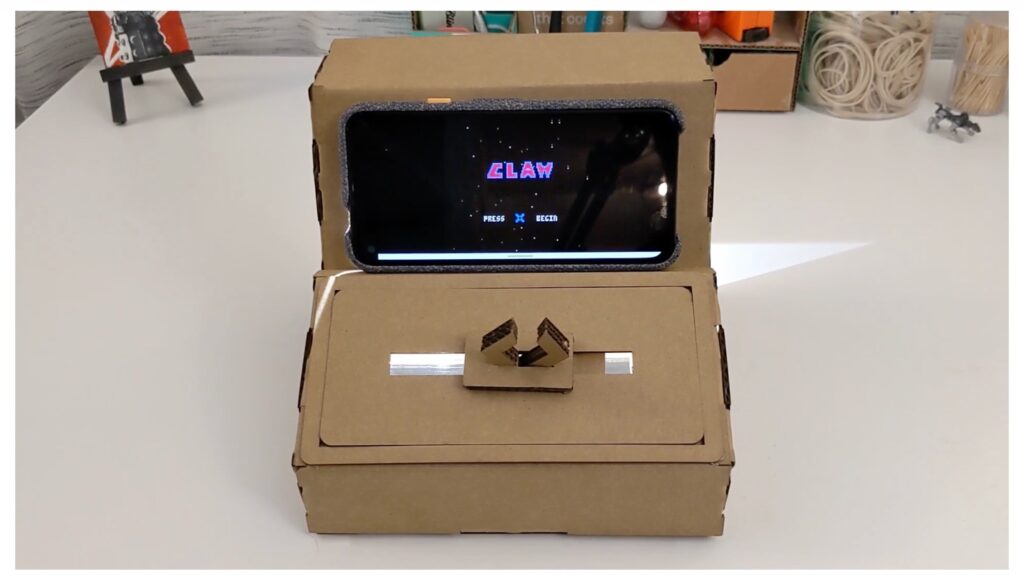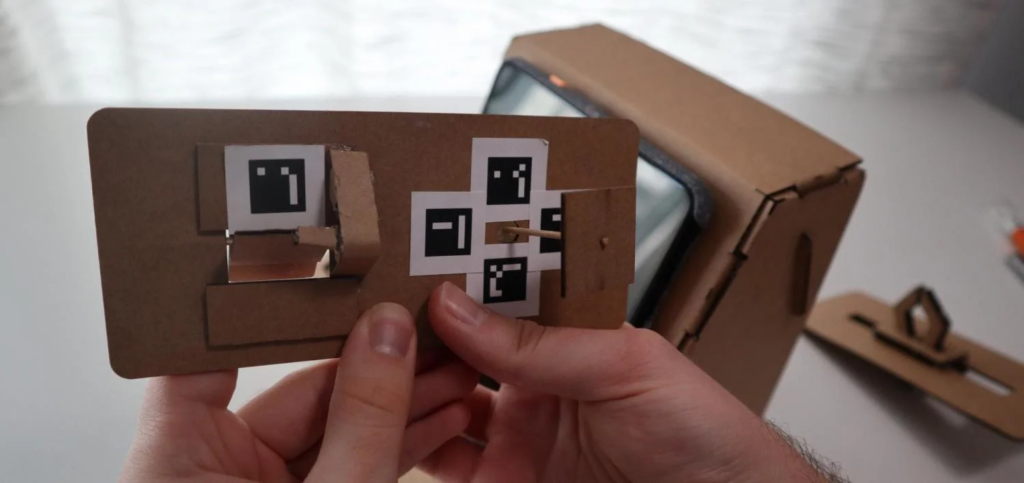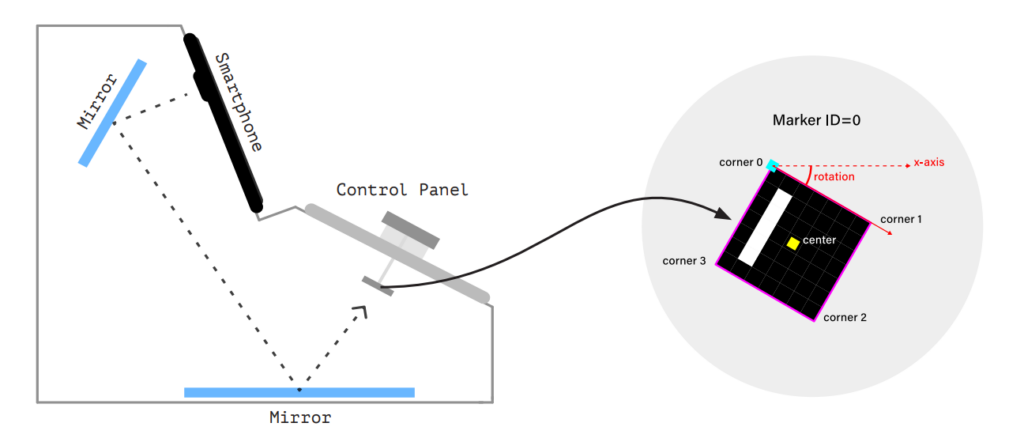In keeping with the spirit of its name, a team at the University of Colorado Boulder’s ACME Lab has created an ‘outlandish’ platform for DIYers to craft Tinycade games and setups.

Despite the jaw-dropping graphics and expansive worlds in today’s games, there is something special about old-school arcade games, which don’t offer the same flash, but something else. They are drawn to the tactile feel of these older video games. There’s something magical about maneuvering knobs or pointing a controller at the actual screen.
Take a look at the Nintendo Labo. It helped change what playing video games could mean. Announced in 2018, Labo Kits are two toys in one: One low-tech and one high-tech that work together in a game. Gamers, or their parents, assemble printed cardboard cutouts and other materials to construct a physical cardboard device for that particular kit (for instance, a fishing rod or vehicle). The user’s Nintendo Switch, serving as the display, is then placed within the constructed device, usually along with the controllers, as detailed in the game’s instructions. Players utilize the so-called Toy-Con construct to interact with included game software.
Despite the novelty and ability of Labo Kits to capture the magic of childhood play, the Labo did not produce the sales needed to sustain its continued development and support.
A big developer’s loss, however, just may be a fledgling company’s gain.
Enter Tinycade. Tinycade is a project of the ACME Creativity Machine Environment (ACME) Lab at the University of Colorado’s interdisciplinary ATLAS Institute for radical creativity and invention. Directed by professor Ellen Yi-Luen Do, ACME tries to live up to its “Looney Tunes” reference as an organization “that makes everything.” Their lab is dedicated to projects like Tinycade that create technology to help people be more creative.
With Tinycade, the ACME Lab plans to do just that while taking the creativity associated with the Nintendo Labo to the next level with a platform for designing games that use alternative controllers built easily by hand. Gamers make their own mini arcade cabinet with fun controllers fabricated using common household materials (cardboard, paper clips, rubber bands, and so forth). Then they are encouraged to try their own hand at game design and make their own games.
Peter Gyory , like many of us, spent quarantine during the pandemic at home. Unlike many of us, he has a bachelor’s degree in game design, a master’s in creative design, and is a doctoral student at the ATLAS Institute. You can view his various papers here. During the doldrums of quarantine, missing the opportunity to design games, he struck gold as he stared at the cardboard in his house.
Most would have seen it as trash; Gyory saw it as a potential game device. “The restriction I gave myself was that if you couldn’t go to the grocery store and buy it, I couldn’t use it in Tinycade,” Gyory said. The instructions for assembly include an example that uses a grocery box. That is an absurdly low bar for entry.

The end result is a cardboard DIY setup. All the Tinycade games use the same cabinet structure: A smartphone rests on the stand, and two mirrors allow the phone’s rear camera to see the bottom of the control panel—computer vision, if you will. The secret is using the gamer’s phone as both the screen and to read the controllers. As the gamer plays, the back camera reflects through the two mirrors to read stickers on the bottom of the control panel. These stickers are just paper blotted with a marker. The phone will read the markers as moving, and the game will register them as movement, making for seamless gameplay.
The panel changes for every game. Gamers play Claw by sliding around their cardboard claw and squeezing it to attack invaders, bringing the tactile experience of arcade gaming to their home. In Lightcycles, the player uses a directional pad and a switch to turn their trail on and off.
The magic of Tinycade is not only that anyone can make a cabinet in one visit to a grocery or hardware store, but that it also includes fun, tactile controls.
Gyory presented the invention recently at the 14th Association for Computing Machinery’s (ACM) Conference on Creativity & Cognition. Meanwhile, he and his ATLAS Lab teammates continue to refine the project. They plan to ultimately create a platform where players can make their own games with unique controllers, resulting in a community of gamers who can play arcade games with just a PDF of stickers under the control panel and a phone.

Coming soon to cardboard near you
The goal of Tinycade is to build a platform where gamers become game designers and share their creations with one another. “When we started Tinycade, we had two audiences in mind—people who make tiny games and players who have a maker inclination. We wanted to make a simple platform/template that other game designers could build upon in order to make their own tiny arcade experiences. We were inspired by the Pico-8 game engine in this way,” said Gyory, referring to the simplistic game engine released in 2015 that mimics the graphics and sounds of 8-bit games from the ’80s. “The hope is also that by leveraging ‘recycled’ materials [for example, cardboard and toothpicks], we could make the system easy to replicate at home. This way, those players with a DIY bone could build the games themselves at little to no additional cost, instead of just reading about it online. What we really aspire for is to turn these players into game controller designers as well, by making this system accessible to novices and tinkerers.”
Accessibility is fundamentally at the core of Tinycade. DIY gamers can drop by the grocery store and come back with all the materials to make a Tinycade “machine.” Combine the low cost of materials with some creativity, and every gamer has the recipe to become a game designer. This keeps the focus of Tinycade on creativity and not on constraints like funding or using particular game engines.
Tinycade will become an open-source platform for game designers to share game software and how to make a control panel, with interested participants collaborating via the Internet. The platform will start with ACME Lab’s games, and then gamers will be encouraged to create and upload their own titles to the platform. Players become game designers, as they create simple software for games and cardboard control panels that provide novelty. The idea is to keep Tinycade’s base cardboard arcade cabinet and switch out control panels for different games.
Cardboard, mirrors, paper, marker, and tape. After that, the only limit is the creativity of the designers. The Tinycade team is currently showcasing three of their games, and according to Do, more games are already in development.
Finding different perspectives
“Think about it: Why should one use the keyboard and mouse to control motion in games that could be reeling in a fishing line, riding a horse, jumping, or flying?” Do questioned.
Why, indeed. Why not play a crane game with an actual crane? Some may recall the N-Zap light gun, a device (controller) shaped like a pistol that was used to in the Nintendo Splatoon series. It may look familiar to children of the ’80s, as it resembles the NES Zapper used to shoot virtual ducks in Duck Hunt. Simply put, arcade-style games, with their non-traditional controls (racing wheel, guitar, and more), are especially fun. Tinycade offers that novelty of game design to the players, to make inventive new controls that can change how we think of gaming.
Gyory and ACME Lab have already tested the design of their platform, and the results are astounding. Within a couple of hours at a controller workshop hosted by Gyory, Tinycade users generated over a dozen controller alternatives.
In fact, Tinycade is just one of many projects ACME Lab and the Atlas Institute have developed to change how we see things. Just like their Looney Tunes counterparts, they truly make everything from a laser chess to an augmented reality app that improves safety for those who work with energy storage. The lab helps us see daily life in a new light.
ACME Lab projects, including Tinycade, can be viewed here.
Want to build your own arcade? Check out Tinycade here.






